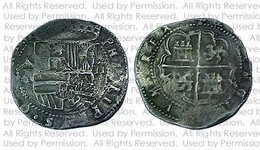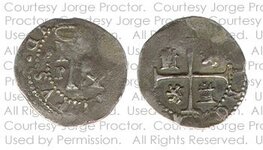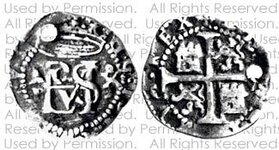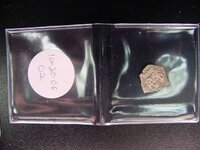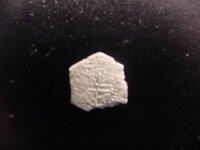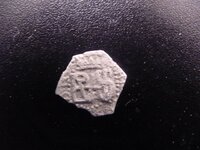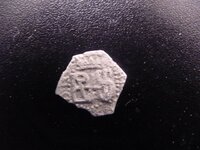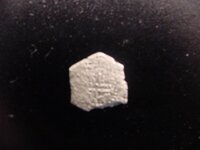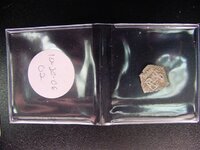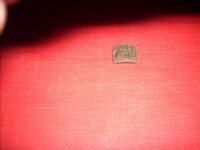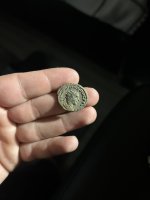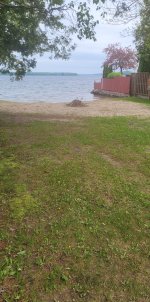divewrecks
Bronze Member
- Sep 7, 2004
- 1,038
- 24
- Detector(s) used
- Minelab Explorer SE (land), Aquapulse AQ1B (sea), Fisher CZ-20 (water, beach), Fisher 1266X (woods)
If you ever run across a cob with the "AP" mint on it you would be wise to keep hang on to it!
Stan
Prior to the 1990, the mint in Panama had been pretty much forgotten, especially in the English speaking world. A few scholars such as Humberto Burzio who wrote Diccionario de la Moneda Hispanoamerica" in 1954 claimed that there had been a mint in Panama, but they knew little about it. It was known that a small handful of cobs had the mint mark "AP", but the mint referred to was a mystery. Some thought the mark might refer to "Alto Peru" or "Upper Peru". But all that was available was theories and speculation without evidence. The mint had been all but forgotten.
Then in 1977, there appeared an article in a relatively obscure journal "Boletin informativo del Archivo Nacional de Panama", Volume 7, June 1977 by Guillermo Diez Morales claiming that the "AP" mint mark belonged to a mint in Panama which operated starting in 1580. Morales talked about documents in the Archives of the Indies in Spain which authorized the Panama Mint and gave operational instructions including the mint mark. Later on this information became available to the English-speaking world when an article by Sewell Menzel appeared "The Numismatist" of June, 1990 (Volume 103, Number 6). Since then scholars such as Jorge Proctor have continued to do research in the Spanish archives. New information has come to light and some old ideas were found to be mistaken.
History
In the 1570's in Spanish Colonial America there was a lack of coins with which to do business. The Spanish administration for the Spanish colonies in America (the Council of the Indies) was studying the problem, and planning the location of an additional mint, perhaps at Cartagena. Officials in Panama however got the ear of King Phillip II and asked that a mint be established in Panama. Panama had no source of silver (only gold), so the request did not make that much sense. But the king was convinced and the Council of the Indies deferred to the wishes of the king. In March of 1578 a royal decree directed that (Old) Panama City be proclaimed the site of a new mint. More decrees followed in 1578 and 1579 describing the positions of mint personnel that would be needed and indicating that the tools and dies were being sent to Panama. After a delay due to some broken equipment, the mint started operations in 1580.
The mint mark of Panama was specified as a monogram for Panama, a "P" (the first letter in Panama) with the last letter "A" on top of the "P". The mint mark thus looks like "AP", and some have speculated this stood for "Audiencia de Panama" (which can be translated to English as "Judicial Tribunal of Panama"). However, the original documents make it clear that the mintmark was a monogram similar to the "O" over "M" used for "MEXICO".
The decrees also specified that Panama was to mint coins in the denominations of 1/2 real, 1 real, 2 real and 4 real. They were not authorized to mint the 1/4 real, 8 real (Pieces of Eight or Spanish Dollar) coins nor gold. Examples of all the authorized denominations have been found with the "AP" mintmark.
Production continued probably until 1583. Documents are known from the mint for 1580, 1581 and through March of 1582. No documents were sent from Panama for the remainder of 1582 and through April of 1583, so little is known about production during that time period. In 1583 an audit was conducted of the Royal Treasury of the city of Panama and a significant amount of money was discovered missing. It is possible that the missing money was part of a scheme to provide silver for the Panama City mint. Analysis of the metal in the AP cobs shows that the silver used was mined in Peru. In any event, no mint production is known to have occurred after the audit was conducted.
Why was the mint ever opened if Panama had no silver to mint? The key may lie in old Spanish documents examined by Jorge Proctor. In these documents the officials in Panama are presenting King Phillip the Second of Spain with samples of the silver coins minted in Panama and requesting permission to mint gold as well. Minting gold would have been a lucrative venture for whichever persons got the contract, especially if they were allowed to mint gold from other regions as well as Panama. From what we know, it appears that the mint had to shut down without gaining approval from the king to mint gold. No gold cobs are known for the AP mint mark. In fact, the Spanish government did not authorize any gold to be minted anywhere in the New World until the later part of the 17th century.
Design
The design of the cobs was dicatated by the Council of the Indies for all the colonial mints and master dies provided. The mint mark and assayer were added to the working dies. Almost all cobs only show part of the design, as the cobs in general were smaller in diameter and thicker than what would be needed to fit the whole design.
Collecting Panama Mint Cobs
Collecting the issues of the Panama Mint is for the very few. Approximately 43 coins are known in total. Several varieties only have one known specimen. The most common specimens may sell for approximately $3000, and prices go up from there. So the majority of us will have to be satisfied with looking at the pictures.
Stan
Prior to the 1990, the mint in Panama had been pretty much forgotten, especially in the English speaking world. A few scholars such as Humberto Burzio who wrote Diccionario de la Moneda Hispanoamerica" in 1954 claimed that there had been a mint in Panama, but they knew little about it. It was known that a small handful of cobs had the mint mark "AP", but the mint referred to was a mystery. Some thought the mark might refer to "Alto Peru" or "Upper Peru". But all that was available was theories and speculation without evidence. The mint had been all but forgotten.
Then in 1977, there appeared an article in a relatively obscure journal "Boletin informativo del Archivo Nacional de Panama", Volume 7, June 1977 by Guillermo Diez Morales claiming that the "AP" mint mark belonged to a mint in Panama which operated starting in 1580. Morales talked about documents in the Archives of the Indies in Spain which authorized the Panama Mint and gave operational instructions including the mint mark. Later on this information became available to the English-speaking world when an article by Sewell Menzel appeared "The Numismatist" of June, 1990 (Volume 103, Number 6). Since then scholars such as Jorge Proctor have continued to do research in the Spanish archives. New information has come to light and some old ideas were found to be mistaken.
History
In the 1570's in Spanish Colonial America there was a lack of coins with which to do business. The Spanish administration for the Spanish colonies in America (the Council of the Indies) was studying the problem, and planning the location of an additional mint, perhaps at Cartagena. Officials in Panama however got the ear of King Phillip II and asked that a mint be established in Panama. Panama had no source of silver (only gold), so the request did not make that much sense. But the king was convinced and the Council of the Indies deferred to the wishes of the king. In March of 1578 a royal decree directed that (Old) Panama City be proclaimed the site of a new mint. More decrees followed in 1578 and 1579 describing the positions of mint personnel that would be needed and indicating that the tools and dies were being sent to Panama. After a delay due to some broken equipment, the mint started operations in 1580.
The mint mark of Panama was specified as a monogram for Panama, a "P" (the first letter in Panama) with the last letter "A" on top of the "P". The mint mark thus looks like "AP", and some have speculated this stood for "Audiencia de Panama" (which can be translated to English as "Judicial Tribunal of Panama"). However, the original documents make it clear that the mintmark was a monogram similar to the "O" over "M" used for "MEXICO".
The decrees also specified that Panama was to mint coins in the denominations of 1/2 real, 1 real, 2 real and 4 real. They were not authorized to mint the 1/4 real, 8 real (Pieces of Eight or Spanish Dollar) coins nor gold. Examples of all the authorized denominations have been found with the "AP" mintmark.
Production continued probably until 1583. Documents are known from the mint for 1580, 1581 and through March of 1582. No documents were sent from Panama for the remainder of 1582 and through April of 1583, so little is known about production during that time period. In 1583 an audit was conducted of the Royal Treasury of the city of Panama and a significant amount of money was discovered missing. It is possible that the missing money was part of a scheme to provide silver for the Panama City mint. Analysis of the metal in the AP cobs shows that the silver used was mined in Peru. In any event, no mint production is known to have occurred after the audit was conducted.
Why was the mint ever opened if Panama had no silver to mint? The key may lie in old Spanish documents examined by Jorge Proctor. In these documents the officials in Panama are presenting King Phillip the Second of Spain with samples of the silver coins minted in Panama and requesting permission to mint gold as well. Minting gold would have been a lucrative venture for whichever persons got the contract, especially if they were allowed to mint gold from other regions as well as Panama. From what we know, it appears that the mint had to shut down without gaining approval from the king to mint gold. No gold cobs are known for the AP mint mark. In fact, the Spanish government did not authorize any gold to be minted anywhere in the New World until the later part of the 17th century.
Design
The design of the cobs was dicatated by the Council of the Indies for all the colonial mints and master dies provided. The mint mark and assayer were added to the working dies. Almost all cobs only show part of the design, as the cobs in general were smaller in diameter and thicker than what would be needed to fit the whole design.
Collecting Panama Mint Cobs
Collecting the issues of the Panama Mint is for the very few. Approximately 43 coins are known in total. Several varieties only have one known specimen. The most common specimens may sell for approximately $3000, and prices go up from there. So the majority of us will have to be satisfied with looking at the pictures.


